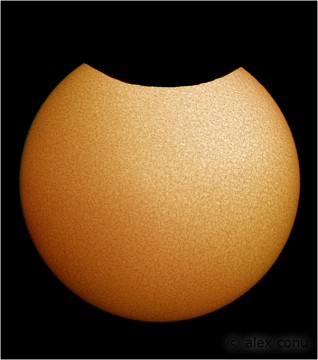Find everything you need to enjoy today's partial solar eclipse — where to go, what you'll see, weather forecasts, and — just in case — an online backup plan.
Need an excuse to take a mid-afternoon coffee break? Try this one: “Back in a few minutes, boss. There’s a partial solar eclipse going on right now!” Grab your coffee, your appropriate eye protection, and your supervisor, then head outdoors to watch to the show.
What will you see?

Alexandru Conu
This is a partial solar eclipse, and your location will determine how much of the Sun appears darkened by the Moon’s silhouette. Action begins near the Kamchatka Peninsula and edges eastward, deepening as the Moon moves along its orbit. The farther north you are, the deeper the eclipse you’ll see; the farther west, the higher the Sun and Moon will be in the sky.
The eclipse will be modest for viewers in southern Mexico, but viewers in the northern half of the country could see 30% to 40% of the Sun “go dark” in the late afternoon. On the West Coast — in San Francisco, for instance — look for about half of the Sun to be by covered by mid-afternoon. For viewers in northern Canada (Yukon and western Northwest Territories), the Moon will eat 70% to 80% of the Sun. From the central region of North America — Alabama, Michigan, Ontario, eastern Nunavut — the deepest point of the eclipse will coincide with setting of the Sun; if located there, you might have the most interesting view of all!
If you’re east of the imaginary line that runs from the Florida Panhandle through the center of Hudson Bay, you should be able to see some of the eclipse, but the Sun will set before it reaches maximum. If you live in the Northeast — New England, the Maritimes — you’re out of luck. Sunset will spoil your show.
Clear Skies?
Your view of the solar eclipse depends as much on the weather as it does your position on Earth. Most of the weather apps and websites get their data from the National Weather Service (NOAA). The interface looks a bit old school, but a single click on the weather map will provide a good look at your regional weather. This can be helpful if you want to seek out nearby cloud breaks. Weather Underground supplements NOAA data with reports drawn from a system of personal weather stations. Their real-time weather updates may be also useful to eclipse chasers.
Watch Online
Here at Sky & Telescope, we’re suffering through a nor’easter; even if we were positioned perfectly to view the eclipse (we're not), we’d be rained out. So we’re going to watch it online instead. Join us!
Need More Information?
Have questions about the eclipse? We have answers. Not sure if you’ll be able to see it? We can help you figure it out. And remember: never look at the Sun without appropriate eye protection!
Use the 2015 Sky & Telescope Observing Wall Calendar to plan your next skywatching session!
 0
0









Comments
You must be logged in to post a comment.